AI Teammates: Transforming Collaboration and Team Performance
Updated On: November 13, 2025 by Aaron Connolly
What Are AI Teammates?
AI teammates are autonomous artificial intelligence systems that work right alongside people, taking on complex tasks without needing someone to watch over them all the time.
Unlike basic chatbots, these AI teammates learn from data, adapt to changes, and handle multi-step workflows on their own.
Defining AI Teammates in the Workplace
Think of AI teammates as digital colleagues that blend into your workspace.
Traditional software tools usually wait for you to tell them what to do, but AI teammates watch for changes and take action using the data you give them.
Key characteristics include:
- Autonomous operation – They work with little human oversight.
- Continuous learning – They get better with experience and feedback.
- Proactive behaviour – They anticipate needs instead of just waiting for instructions.
These systems plug into your existing business tools, like HR platforms or calendars.
They pull info from several sources at once, spot patterns, and then respond as needed.
For example, in customer service, an AI teammate might monitor support tickets, spot urgent ones, and send them to the right team member while drafting a first reply—all without being told to do so.
The tech behind these teammates mixes large language models with decision-making algorithms.
This combo lets them understand context, plan out multi-step tasks, and shift their approach when things change.
AI Teammates Versus AI Agents and Chatbots
Knowing the difference between these systems helps you pick the right one for your team.
Chatbots are great at structured conversations and answering common questions using pre-set dialogue flows.
AI agents cover a bigger range—they can handle lots of different tasks on their own.
AI teammates are basically specialised AI agents built for working with people in team settings.
| Feature | Chatbots | AI Agents | AI Teammates |
|---|---|---|---|
| Autonomy | Low | High | High |
| Learning | Minimal | Moderate | Continuous |
| Workflow Integration | Limited | Variable | Deep |
| Context Awareness | Basic | Advanced | Advanced |
| Proactive Actions | None | Some | Extensive |
Chatbots need you to prompt them every time and stick to scripts.
They’re perfect for FAQs or simple info lookup, but they can’t manage complicated, multi-step tasks.
AI teammates take things further.
They look at how we communicate, keep track of project timelines, and coordinate between people and systems—often without us having to spell things out.
Core Capabilities of AI Teammates
AI teammates shine when things get messy or unclear—situations where regular automation tends to fall apart.
They process unstructured data, fill in blanks, and make reasonable decisions about what to do next.
Workflow automation is probably their strongest suit.
These systems can run entire processes from beginning to end, including dealing with exceptions and escalating problems.
They learn your team’s unique procedures and tweak their approach as needed.
Real-time adaptation really sets them apart.
When priorities shift or surprises pop up, AI teammates adjust instantly—no need for someone to reprogram them.
Multi-system integration means they juggle data across different platforms at once.
They’ll grab info from your email, update project trackers, and ping teammates through whatever channel you use.
Predictive capabilities let them spot bottlenecks, resource gaps, or problems before they slow you down.
This proactive style helps head off trouble instead of just reacting to it.
Security and compliance are baked into how they work.
AI teammates know your organisation’s policies and regulatory needs, so their actions stay within the rules and leave audit trails for everything they do.
How AI Teammates Support Teamwork
AI teammates are changing the way we work.
They boost team communication, share knowledge instantly, and jump in to help when it matters most.
By handling routine stuff and surfacing insights we might miss, they make teams sharper and more efficient.
Enhancing Collaboration Between Humans and AI
Getting people and AI to work well together doesn’t just happen—you have to plan for it and set clear expectations.
Start with simple tasks, then gradually let AI teammates take on more as everyone gets comfortable.
Trust grows over time as teams see steady results.
Many folks find that AI teammates work best when they handle specific jobs, like data analysis or scheduling.
That frees up people to focus on creative work and big decisions.
Transparency is key.
We need to know what our AI teammates can and can’t do.
When AI explains its suggestions clearly, we tend to trust it more and make better choices as a group.
| Best Practices | What It Means |
|---|---|
| Start small | Begin with basic tasks like email sorting |
| Set clear roles | Define what AI handles vs humans |
| Regular check-ins | Review AI performance weekly |
| Open communication | Discuss AI suggestions as a team |
Teams that treat AI as a real teammate—not just another tool—usually see stronger results.
Facilitating Expertise Sharing Across Teams
AI teammates are great at gathering knowledge from different people and sharing it when it’s needed.
They remember best practices, past project details, and can connect you with others facing similar challenges.
Knowledge gaps shrink when AI teammates help us find the right expert or info fast.
No more spending hours digging for answers—you get what you need right away.
AI teammates also catch patterns we might overlook.
They notice when different teams solve similar problems and suggest ways to share those solutions.
This helps us avoid repeating work that’s already been done.
Smart AI systems learn from our interactions and get better at matching people with expertise.
They track who worked on which projects and can point you to the best person to ask about a specific topic.
Empowering Teams With Real-Time Assistance
Real-time help from AI teammates keeps things moving.
They answer questions on the spot, suggest next steps, and flag problems before they get out of hand.
Productivity goes up because we don’t have to pause work to hunt down information.
AI teammates can pull up relevant documents, check project status, and give updates without breaking our flow.
During meetings, AI teammates take notes, track action items, and even suggest agenda topics based on current projects.
That lets people focus on the conversation and solving problems.
Just a heads-up: AI teammates work best when we give them clear instructions and regular feedback.
The most effective ones adapt to our style and preferences.
They learn when we want detailed explanations or just quick summaries, and they change how they communicate to match.
Key Features and Functions of AI Teammates
AI teammates work as autonomous systems that take care of entire business functions, not just single tasks.
They plug into your usual tools and learn your team’s quirks, so you get results without having to micromanage.
Integrating With Existing Workflows
Modern AI teammates hook right into the platforms your team already uses.
They pull data from several places and update different systems at the same time.
Most of them play nice with both old legacy systems and the latest tech.
This creates a unified workflow so you don’t have to keep switching between apps.
Key integration capabilities include:
- Email management systems
- Project tracking tools
- Customer relationship management platforms
- Document storage and collaboration apps
- Communication channels like Slack or Teams
Setting everything up usually takes a few days to a couple of weeks, depending on your setup.
Once connected, AI teammates can handle data synchronisation across platforms automatically.
They also keep detailed logs of every system interaction, which makes it easier to track changes and stay compliant with regulations.
Adapting to Organisational Context
AI teammates learn from every interaction and task.
Over time, they pick up your team’s preferences and working habits.
Unlike generic AI tools that use standard info, these systems build knowledge from your actual meetings and decisions.
They remember details from past discussions and link insights across projects.
Adaptation features include:
- Learning team communication styles
- Understanding company-specific terminology
- Recognising workflow preferences
- Adapting to different departmental needs
- Following established approval processes
Learning happens quietly in the background.
AI teammates adjust their responses and suggestions based on what team members tell them.
They can switch between different team personalities and styles without missing a beat.
This flexibility makes them work well across various departments.
Task Automation and Process Management
AI teammates are really good at repetitive tasks that usually eat up a lot of time.
They get these jobs done quickly and accurately.
Common automated tasks include:
- Data sorting and analysis
- Document formatting and creation
- Meeting scheduling and calendar management
- Report generation from multiple data sources
- Email drafting and response management
These systems can handle multi-step workflows on their own.
For example, they might analyse meeting notes, build out project timelines, assign tasks based on team strengths, and create progress reports.
AI teammates also juggle process management across several projects at once.
They keep an eye on deadlines, watch progress, and alert team members to issues before things get messy.
The automation runs in the background, no breaks needed and no extra instructions.
That means people can focus on strategy and creative problem-solving.
Popular Platforms and Tools Featuring AI Teammates
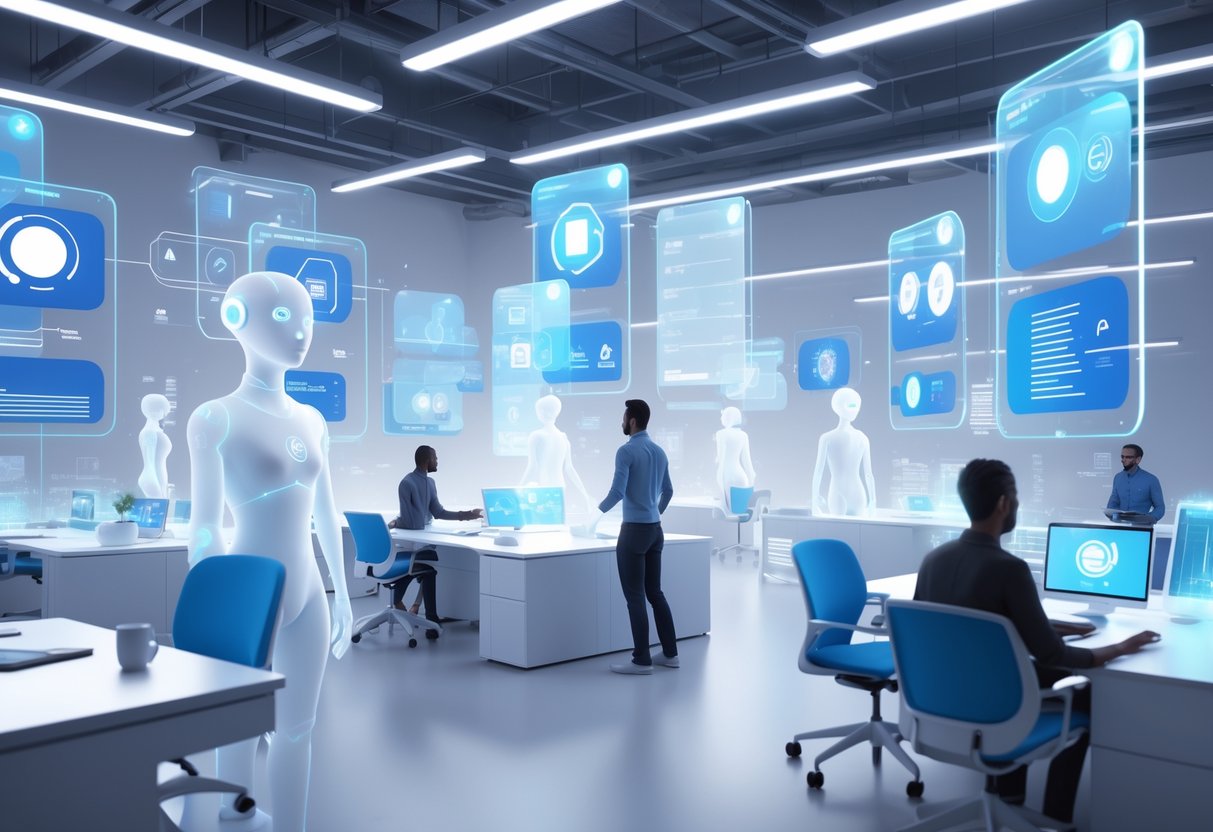
A bunch of popular platforms now include AI teammates to make workflows smoother and cut down on repetitive work.
These systems use machine learning to automate status updates, generate project summaries, and offer smart suggestions for keeping teams on track.
Asana’s Approach With Work Graph
Asana built its AI teammate system around a macro-management philosophy.
Their AI aims to cut down on admin work instead of micromanaging every little task.
The platform’s AI teammate creates status updates and progress reports automatically.
When you finish tasks or update milestones, the system puts together summaries for managers.
Less time writing reports, more time actually getting things done.
Smart Goals is another standout.
The AI helps set goals across teams and departments, suggesting measurable objectives based on project types and past data.
Asana uses AI engines from OpenAI and Anthropic, plus its own models.
They let you know which engine powers which feature, and you can opt out of third-party models if you want to stick with Asana’s native AI.
The Smart Editor is handy for writing project descriptions and breaking down tasks.
It’s especially useful for tricky projects where clarity really matters.
Atlassian and Collaborative AI
Atlassian Intelligence acts as an “AI wingmate” across their product lineup, like Trello and other collaboration tools.
The focus is on processing content and breaking down tasks, not heavy automation.
Their AI teammate can summarise long card descriptions and split big tasks into smaller steps.
It also helps brainstorm ideas when teams get stuck during planning.
Grammar and spelling help runs in the background on all text inputs, so your communication stays polished without extra effort.
One thing we’ve noticed: Atlassian’s AI isn’t great at workflow automation.
It’s better for generating content and clarifying tasks than managing processes.
The AI is only available on Premium and Enterprise plans, so smaller teams might miss out.
Still, once it’s enabled, it fits right into existing Atlassian workflows.
WorkSpan and Partner Operations
WorkSpan focuses on partner ecosystem management with AI teammates built for complex business relationships.
Their system coordinates between organisations and stakeholders.
The AI teammates track partner performance metrics and flag issues early.
This covers project timelines, budgets, and communication gaps.
Automated reporting creates partner scorecards and relationship health summaries.
These reports help business development teams see which partnerships need attention.
WorkSpan’s AI also manages contract milestones and renewal dates.
It sends alerts to the right people and suggests action items based on how partnerships are performing.
The system connects with CRM and project management tools, giving you a single view of partner relationships across your business.
Generative AI In AI Teammates
Generative artificial intelligence is changing how AI teammates operate.
With natural language conversations, independent decision-making, and seamless integration into existing systems, these AIs finally feel like true collaborators—not just passive tools.
Natural Language Processing and Understanding
Generative AI teammates really shine when it comes to picking up on context and subtlety in human conversations. They interpret complicated instructions, throw out clarifying questions, and shift their responses to fit the vibe of the team.
Unlike old-school chatbots, these AI systems actually get implied meanings and cultural references. They can tell when we’re just tossing ideas around versus making a final call. This kind of awareness lets them pitch in more naturally, no matter what kind of conversation we’re having.
Key communication abilities include:
- Understanding industry jargon and technical terms
- Adapting tone to match team culture
- Remembering previous conversations and context
- Interpreting emotional cues in written communication
Harvard Business School research suggests that AI’s language-based interface sparks more positive emotions among team members. People often say they feel more energized and excited when collaborating with AI teammates instead of just using standard tools.
The natural conversation flow makes it way easier to get started. Team members don’t have to memorize special commands or go through extra training just to talk to their AI colleagues.
Action-Taking and Decision-Making Abilities
Modern generative AI doesn’t just follow orders—it can make its own decisions within set boundaries and actually take action to get things done. This level of autonomy sets AI teammates apart from basic automation.
AI teammates juggle multiple variables at once to suggest solutions. They weigh speed, cost, and quality based on the priorities we set for the project. If things get murky, they lay out the options and explain their reasoning instead of just picking randomly.
Decision-making capabilities include:
- Prioritising tasks based on deadlines and importance
- Allocating resources across multiple projects
- Identifying potential risks and mitigation strategies
- Adapting approaches when initial methods fail
Studies show that people using AI can hit the same performance quality as traditional two-person teams. AI teammates help fill in knowledge gaps, so even less experienced folks can deliver results that usually need senior oversight.
Transparency makes a big difference here. Good AI teammates walk you through their thought process, which makes it easier for everyone to understand and, if needed, tweak the approach.
Integrations With Third-Party Systems
AI teammates really come alive when they hook into the software and platforms your team already uses. This lets them grab real-time data and get things done across different systems—suddenly, they’re not just helpers, they’re actual team members.
AI teammates pull info from project management tools, customer databases, and chat platforms all at once. They use what they find to offer up-to-date suggestions and take care of routine tasks without anyone needing to step in.
Common integration capabilities:
- Syncing with calendar and scheduling systems
- Accessing customer relationship management platforms
- Connecting to financial and reporting software
- Interfacing with design and development tools
These integrations mean you don’t have to feed the AI information by hand. They work with the same data as everyone else, which keeps things consistent and accurate across the board.
The best setups keep security tight but still let the AI access what it needs. AI teammates log in through company systems and respect whatever permissions are set for each person.
Integration quality can really make or break it. Teams with well-connected AI teammates finish tasks about 16.4% faster than those sticking to the old ways.
AI Teammates and Team Performance
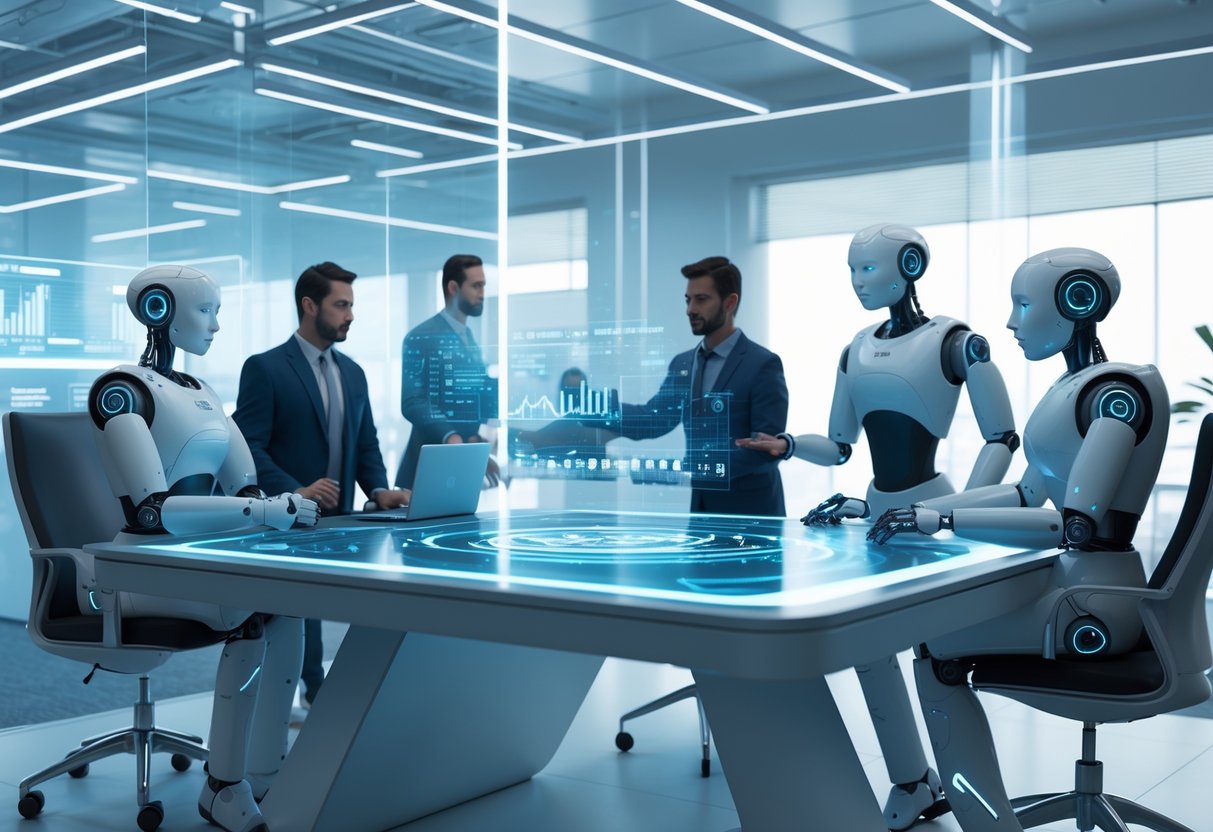
AI teammates can change the way teams work together, but the impact isn’t always straightforward. Research shows mixed results—some parts of teamwork get better, while others run into new hurdles.
Boosting Productivity and Efficiency
AI teammates take on repetitive tasks that usually bog down human players. They process information at lightning speed and don’t get worn out, even during marathon gaming sessions.
Key productivity benefits include:
- Faster data analysis during matches
- Consistent performance without fatigue
- Real-time strategy adjustments
- Reduced time on routine calculations
Plenty of esports teams say AI gives them a leg up on prep work. The tech analyzes opponent patterns and cranks out counter-strategy ideas fast.
But some recent studies throw a curveball. When AI first joins a human team, overall performance often dips. Teams need a bit of time to figure out how to communicate and tweak their workflows.
Productivity gains really show up in specific tasks. AI teammates excel at tracking lots of game elements at once, freeing up human players to focus on creative strategies and big decisions.
Improving Task Execution Accuracy
AI teammates bring impressive accuracy to repetitive gaming tasks. They don’t get rattled by stress or distracted like people do.
Accuracy improvements appear in:
- Timing-critical actions
- Resource management
- Pattern recognition
- Consistent execution of practised moves
Harvard Business Review found that adding AI to teams shakes up how people collaborate. Teams with AI members act differently than all-human groups.
AI teammates keep their performance steady. They don’t have off days or emotional swings that throw off their game. This reliability helps teams plan their strategies more confidently.
Still, accuracy by itself doesn’t guarantee better results. Teams have to learn to communicate smoothly with their AI teammates, and the learning curve can slow things down at first.
Balancing Technical and Commercial Solutions
Teams have to weigh both the technical power and business costs before bringing on AI teammates. The investment should actually pay off in competition results.
Cost considerations include:
- AI software licensing fees
- Hardware requirements
- Training time for human teammates
- Ongoing maintenance and updates
Commercial AI options run the gamut in terms of quality and price. Teams should pick what fits their game and budget, not just chase the fanciest tech.
On the technical side, integration can be tricky. AI teammates have to mesh with existing team communication systems, and a lot of teams underestimate how long setup takes.
Success means finding a balance between cutting-edge tech and what the team actually needs. The priciest AI isn’t always the right fit.
Starting with pilot programs makes sense. Teams can spot problems early without risking a big chunk of their budget.
Collaboration Models: Human and AI Synergy
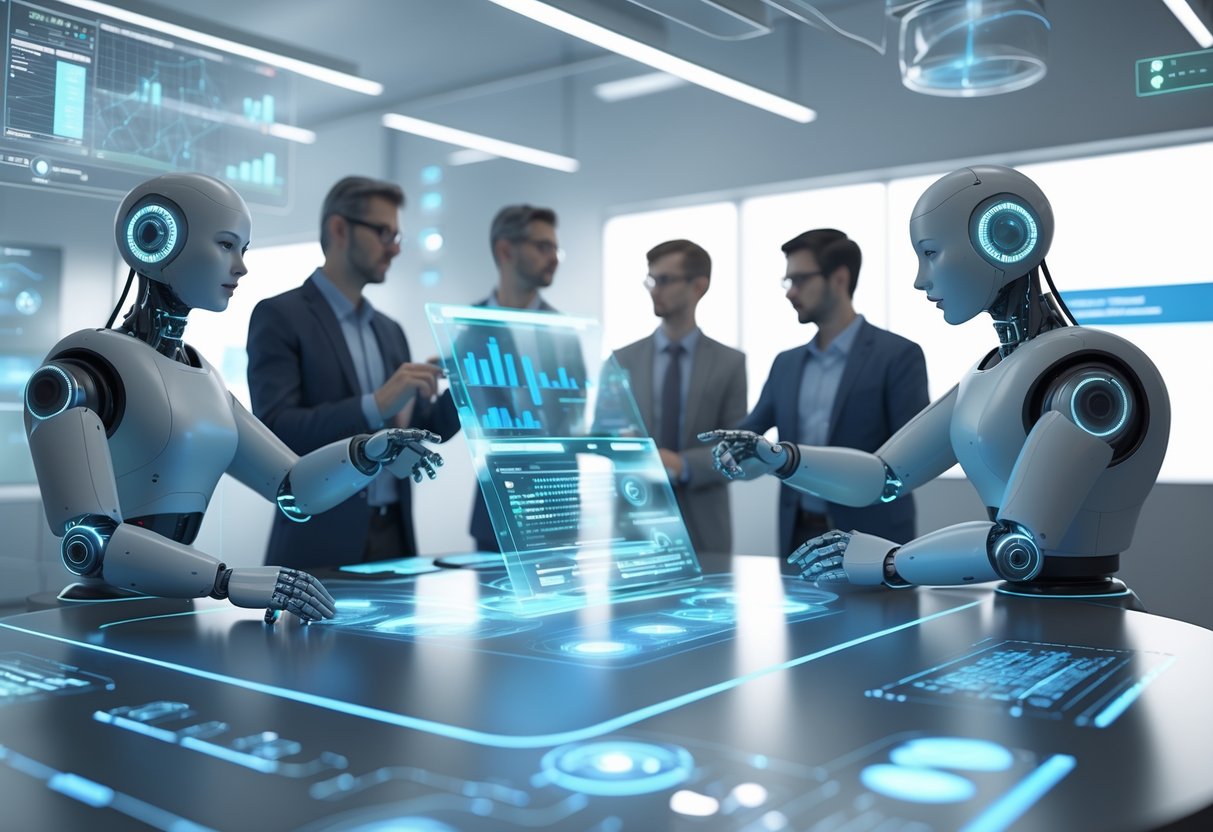
Teams get the best results when humans and AI play to their strengths in structured workflows. That means keeping humans in charge of the big calls, letting people and machines coordinate, and building real trust with AI teammates.
‘Human In The Loop’ Collaboration
The human-in-the-loop approach keeps people front and center for the big decisions. AI handles data processing and pattern-finding, but humans have the final say on strategies and judgments.
In esports analysis, AI crunches match data and spots player habits. Coaches still decide on strategies, using context that AI might miss.
Key benefits include:
- Humans maintain oversight and accountability
- AI speeds up routine tasks
- Critical thinking stays with people
- Errors get caught before they cause problems
Healthcare uses this model too. AI scans medical images and flags issues, but doctors review the results and make the diagnoses.
This works because each teammate does what they do best. AI processes huge amounts of data fast. Humans bring context and complex judgment.
Coordinating Human and AI Workflows
Good teamwork depends on handing out tasks based on strengths, not sticking to rigid roles. AI teammates flex with changing situations, while humans steer the big-picture goals.
Task allocation typically follows this pattern:
| AI Handles | Humans Handle |
|---|---|
| Data processing | Strategic planning |
| Pattern recognition | Creative problem-solving |
| Routine monitoring | Relationship management |
| Real-time analysis | Final decision-making |
Modern workflows shift tasks around based on context. When new tournament data drops, AI might dive into player trends. Human analysts then use those insights to prep for commentary.
Communication in these teams feels more fluid. AI sends updates or recommendations through dashboards and alerts. Humans interpret, adjust, and move plans along.
The trick is to avoid rigid hierarchies. Tasks bounce between AI and humans depending on what the situation calls for.
Building Trust With AI Teammates
Trust doesn’t happen overnight—it grows through reliable performance and real transparency. AI teammates earn credibility by delivering results and being upfront about what they can and can’t do.
Trust builds through:
- Predictable performance – AI consistently delivers quality work
- Clear communication – Systems explain their reasoning and confidence levels
- Honest limitations – AI admits when it’s out of its depth
- Gradual responsibility – Trust grows through small, successful collaborations
Teams often start with low-stakes tasks to see if the AI can deliver. An esports team might first use AI for simple opponent research before letting it suggest strategy.
Transparency is huge. When AI shows its reasoning, humans can catch mistakes early. If the system acts like a black box, people get suspicious.
Regular feedback loops help trust grow. Humans correct AI slip-ups, and AI learns from that feedback. That way, the team moves beyond just automation.
Trust also means knowing when AI isn’t sure. Good AI teammates let you know when their recommendations are shaky. That honesty keeps teams from relying too much on AI guesses.
Use Cases and Real-World Applications
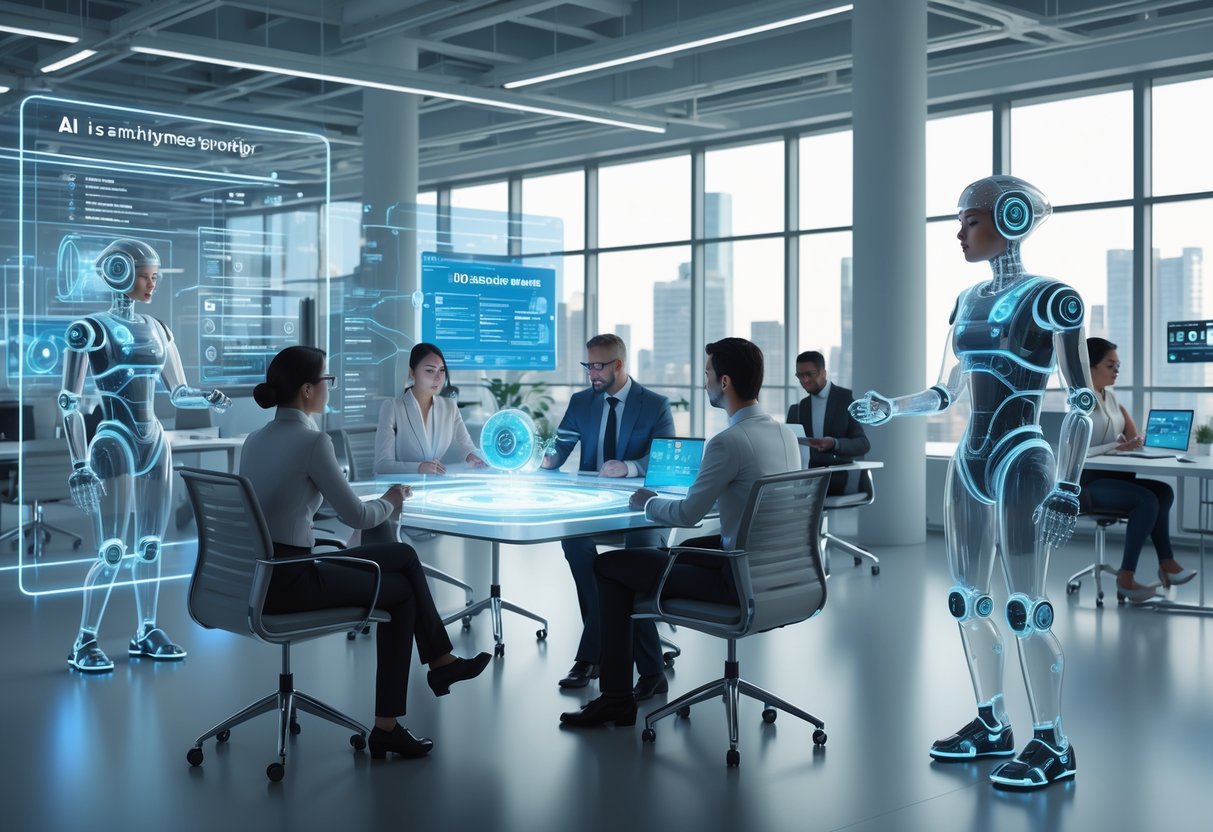
AI teammates tackle three main areas that really move the needle for business efficiency. They take over routine admin work, smooth out project workflows, and ramp up performance in customer-facing roles.
Administrative Task Offloading
We’re seeing AI agents totally change how teams deal with repetitive admin work. In HR, digital teammates write job postings, schedule interviews, and walk new hires through onboarding.
Healthcare practices use clinical assistants that listen during patient visits and draft notes on the fly. This frees up doctors to actually talk to patients instead of staring at a keyboard.
Financial services rely on AI agents for Know Your Customer checks. These agents verify identities and assess risks across banking systems without needing a human to jump in.
Key admin tasks AI handles:
- Document creation and form filling
- Appointment scheduling and calendar management
- Data entry across multiple systems
- Basic employee questions about benefits and policies
The time savings add up fast. Teams say they spend 30-40% less time on routine paperwork when AI teammates take care of the basics.
Project and Process Management
AI agents are great at keeping workflows on track across tools and team members. They monitor project progress, flag delays, and suggest fixes before things go off the rails.
Manufacturing teams use AI agents to analyze equipment photos, estimate repair costs, and schedule maintenance. These agents work through the night, so urgent repairs get flagged before morning.
Software development teams put AI agents on code quality checks, deployment management, and coordinating tests across environments.
Supply chain managers count on agents that analyze weather, supplier performance, and inventory to tweak delivery routes and cut down disruptions.
Project management benefits:
- Real-time progress tracking across departments
- Automated risk assessment and early warnings
- Resource allocation based on current workloads
- Seamless handoffs between team members
With AI on the team, nothing slips through the cracks—even when humans are offline.
Sales, Support, and Partner Operations
Customer-facing teams see quick wins from AI teammates working around the clock. Support teams use agents to sort tickets, read customer sentiment, and suggest fixes.
Sales reps get AI agents to research prospects, update pricing, and draft follow-up emails. These agents pull info from CRM systems and company docs to keep everything up to date.
E-commerce platforms run AI agents for order tracking, returns, and delivery scheduling. Customers get instant answers instead of waiting in line.
Financial advisors use AI agents for credit checks, pulling data from all over, calculating risk, and drafting assessments for review.
Customer operation improvements:
- Faster response times for common inquiries
- Consistent service quality across all channels
- Reduced escalation rates through better initial triage
- Personalised recommendations based on customer history
The end result? Happier customers, and support teams who can focus on the tough problems instead of repetitive questions.
Workflow Optimisation With AI Teammates
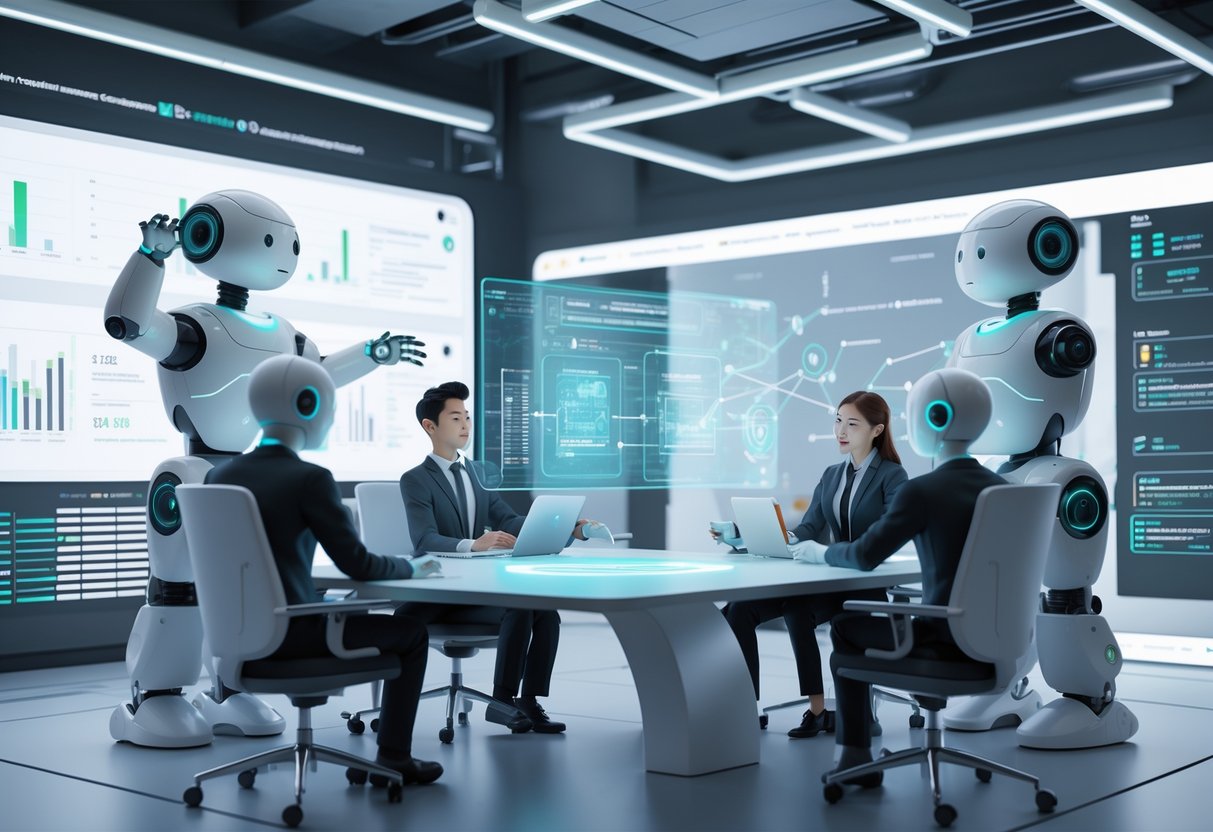
AI teammates change the way teams work by spotting patterns, predicting issues, and handling routine tasks. They use structured data models to make smart choices and give insights that help everyone work more efficiently.
Identifying Bottlenecks and Streamlining Processes
AI teammates are quick to spot workflow hiccups before they slow everyone down. They scan project timelines and point out where things get jammed up.
Common bottlenecks they detect:
- Tasks waiting too long for approval
- Team members overloaded with work
- Missing information that delays projects
- Unclear ownership of tasks
When an AI teammate finds a bottleneck, it acts right away. It might shift work to someone free or flag missing details that are holding things up.
For creative teams, AI teammates triage incoming requests. They collect missing info and send work to the right people based on the project. That means less admin hassle for everyone.
Marketing teams use AI teammates to enforce naming rules and highlight key request details. This speeds up prioritization and keeps projects on track.
Contextual Decision-Making Using Work Graph
The Work Graph ties all your team’s work to company goals. AI teammates use this structure to make smarter decisions with the right context.
Unlike basic AI tools that just sift through random data, AI teammates actually see how your work fits together. They can tell which projects matter most and who should handle specific tasks.
Key advantages of Work Graph integration:
- Reliable recommendations based on structured data
- Full transparency in how decisions happen
- Proper context for every action
- Connection to company objectives
AI teammates don’t just check off tasks at random. They get your team’s priorities and make choices that actually support the bigger picture.
When you launch products, AI teammates coordinate different teams because they see how marketing, development, and sales all connect through the Work Graph.
Proactive Recommendations and Insights
AI teammates don’t just wait around for problems to pop up. They look at your workflows and suggest improvements before you even notice issues.
They offer three kinds of guidance:
- Risk identification – spotting potential problems early
- Process improvements – suggesting better ways to work
- Focus areas – pointing out where attention is needed most
For strategic planning, AI teammates recommend which team members should lead certain workstreams. They base these tips on past performance and current workload.
Real-world examples:
- Flagging projects with unclear ownership
- Suggesting deadline changes before teams get overwhelmed
- Recommending process tweaks for recurring inefficiencies
- Spotting team members who need support
Teams using AI teammates save a lot of time because they catch problems early. Instead of scrambling to fix issues later, they prevent them altogether.
The smart chat interface lets anyone ask about work status and next steps. People spend less time in update meetings and more time actually working.
Challenges and Limitations of AI Teammates
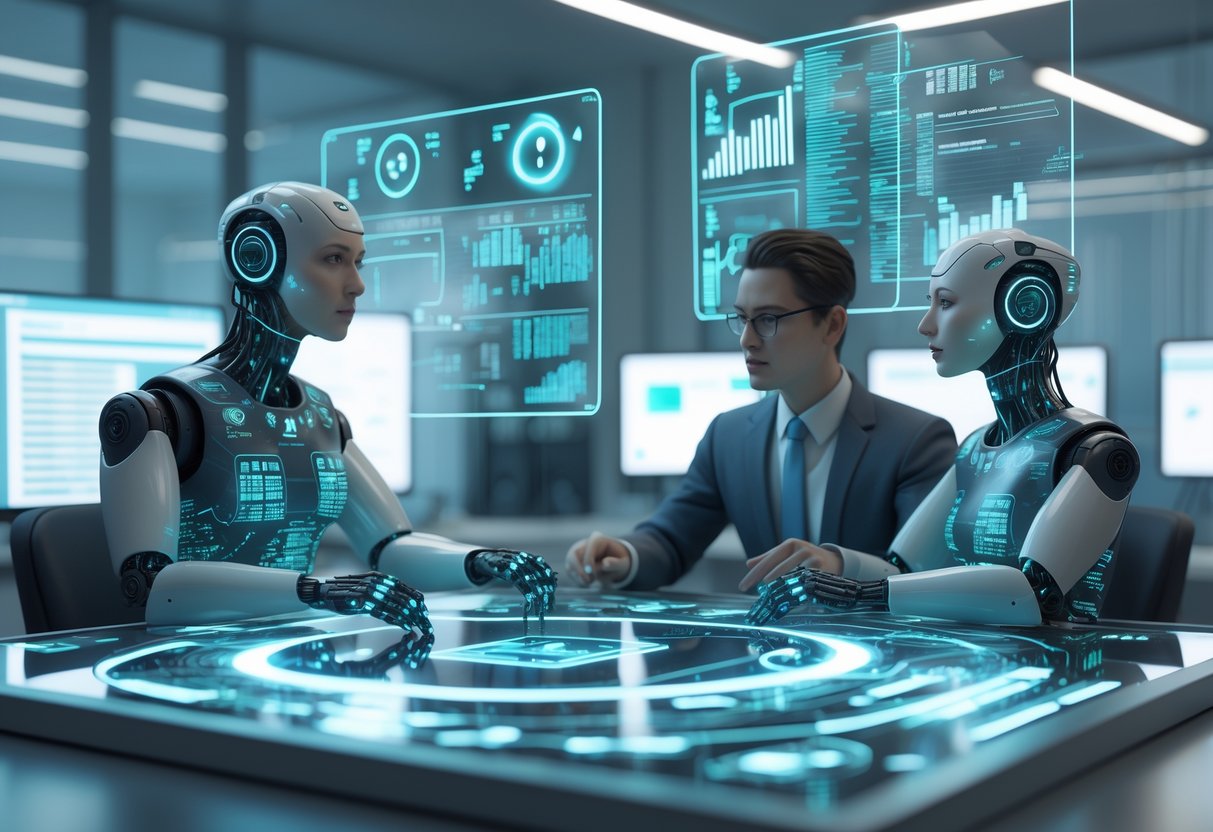
AI teammates bring some real hurdles that teams have to navigate with care. These systems struggle with accuracy, need constant human monitoring, and can create integration headaches that disrupt workflows.
Accuracy and Hallucination Risks
AI teammates sometimes spit out wrong information or just make things up. They do this because they generate responses based on patterns, not true understanding.
Common accuracy problems:
- Making up statistics or tournament results
- Providing outdated team rosters or player info
- Creating fake links between players and organisations
- Mixing up similar-sounding player names or team histories
These “hallucinations” spread fast in team chats. When an AI teammate confidently shares wrong info, people might just trust it without double-checking.
Warning: Always double-check AI-generated facts about players, match results, or tournament schedules before sharing.
Fast-moving esports environments make this worse. AI systems often don’t have the latest roster changes or tournament updates, leaving teams with big knowledge gaps.
Human Oversight and Accountability
AI teammates can’t own up to their mistakes or bad decisions. Human team members have to keep an eye on them and fix their errors.
This actually adds to the workload instead of reducing it. Teams often spend more time checking AI outputs than just doing the job themselves.
Key oversight challenges:
- Deciding when to trust AI suggestions
- Splitting decision-making between humans and AI
- Figuring out who’s responsible when AI teammates mess up
- Training people to spot AI mistakes quickly
Many teams run into expectation mismatches. They expect AI teammates to work like humans but end up managing unpredictable systems instead.
Pro esports teams struggle to decide which tasks to hand to AI. AI does fine with routine data analysis, but it falls short during creative strategy talks.
Integration Complexity
Bringing AI teammates into existing workflows creates both technical and social headaches. Teams have to rethink how they communicate and make decisions.
Technical integration issues:
- Connecting AI to team chat platforms
- Syncing AI with match databases and stats
- Managing different AI abilities across team members
- Keeping AI performance steady during high-pressure matches
Social integration gets tricky too. Human team members can feel unsure about their roles when AI joins. Some people just don’t want to work with artificial intelligence at all.
Teams often underestimate how much time proper AI integration takes. What looks like a quick addition usually needs weeks of adjustment and training.
The esports world moves fast, which makes integration even tougher. Teams need AI teammates who can keep up with new games, rule changes, and tournament formats. Right now, the tech just isn’t that flexible.
Ethics, Transparency, and Data Responsibility
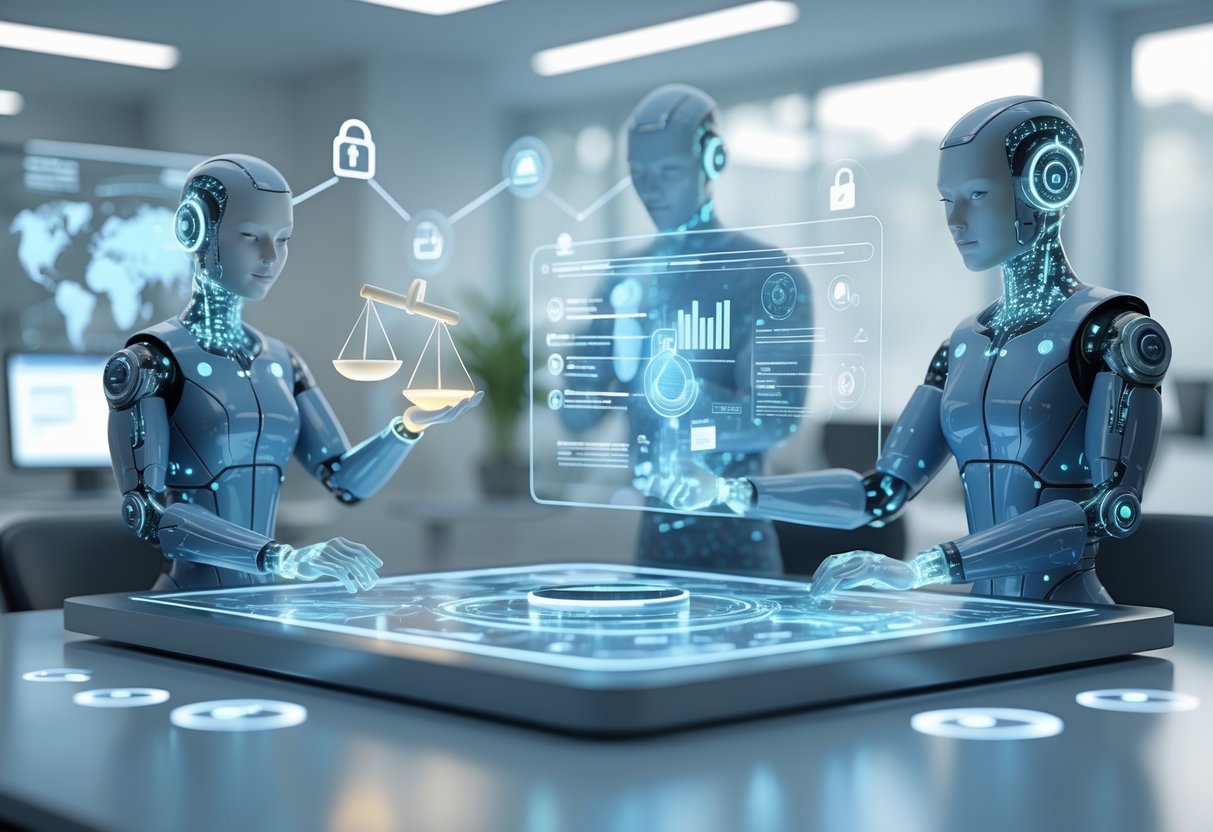
AI teammates have to follow clear ethical rules if they want to earn trust and keep things fair. These systems need strong privacy protections and transparent processes so users can see how decisions happen.
Ensuring Fairness and Avoiding Bias
AI systems can pick up biases from their training data, which leads to unfair treatment of certain groups. We have to actively test AI teammates for discriminatory behaviour across different demographics.
Regular algorithm audits help spot bias issues before they impact real users. Many organisations now have dedicated ethics teams with technical experts, lawyers, and social scientists to review AI decisions.
Key bias prevention strategies:
- Test algorithms with diverse datasets
- Monitor outcomes across user groups
- Set up feedback loops for ongoing improvement
- Train teams to notice bias indicators
Companies that ignore bias risks can face serious legal and reputational trouble. In one case, an insurance AI system discriminated against certain clients based on indirect factors, almost costing the company millions in lawsuits.
Maintaining Privacy and Security
Data protection is at the heart of responsible AI teammate deployment. We have to keep personal information safe while still letting AI systems work well.
Privacy-by-design means building data protection in from the start. Only collect what’s necessary, encrypt sensitive info, and make sure users know what they’re agreeing to.
Essential privacy measures:
- Encrypt data at rest and in transit
- Have clear user consent processes
- Run regular security audits
- Collect only minimal data
- Use secure deletion protocols
Many regions now enforce strict data protection laws with heavy penalties for violations. AI teammates must follow regulations like GDPR while still being useful.
Transparent Process Management
People deserve to know how AI teammates make decisions that affect them. Explainable AI (XAI) helps give clear reasons behind automated choices.
Transparency builds trust between users and AI. When someone gets an automated decision, they should get a simple explanation of the key factors.
Transparency requirements:
- Clear documentation of how AI decisions work
- User-friendly explanations for automated choices
- Regular reports on algorithm performance
- Open communication about system limitations
Banks have rolled out explainable AI models that let customers see why they got certain loan decisions. This has cut complaints and improved satisfaction, while also meeting regulations.
Even with transparent AI, human oversight stays important. We need clear accountability so someone is always responsible for AI-driven decisions.
The Future of Work With AI Teammates
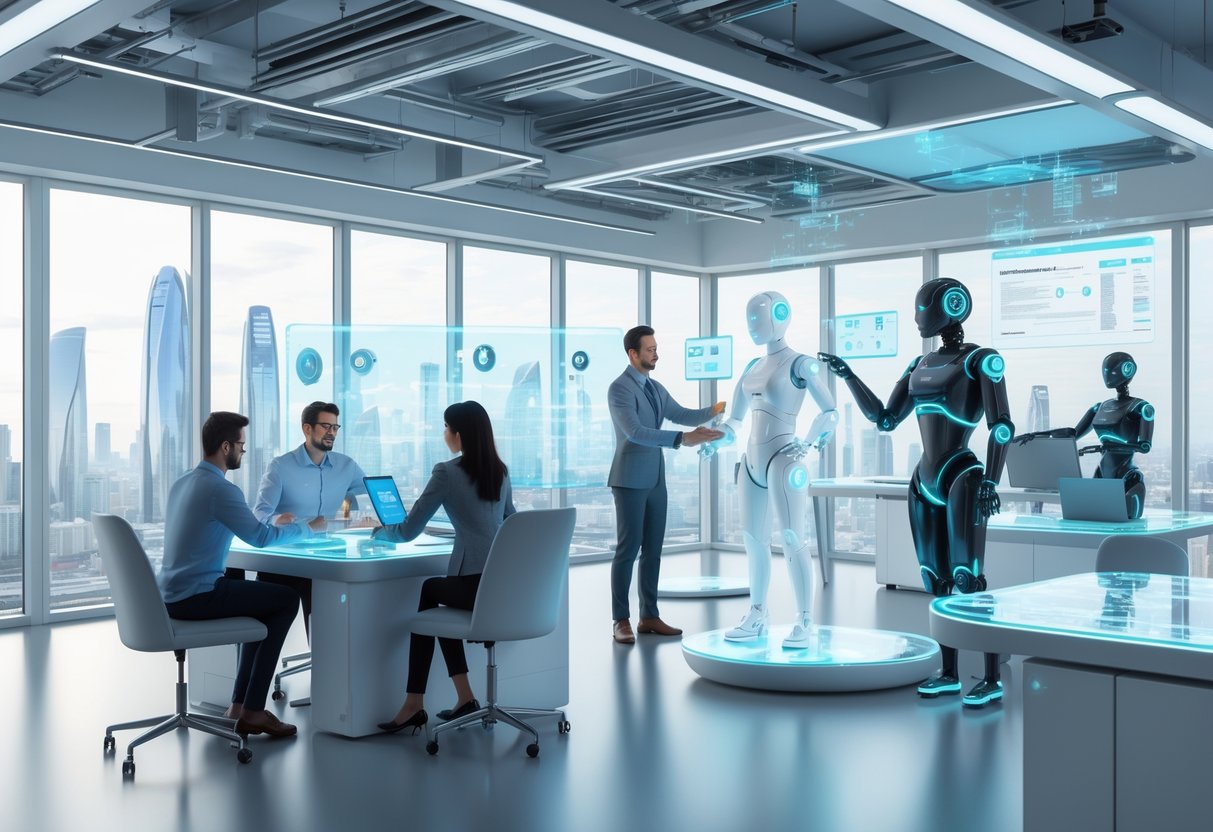
AI teammates are set to reshape how we work—changing team roles, scaling across organisations, and creating new structures. Workers who treat AI as partners actually report 33% higher productivity than those who see it as just another tool.
Evolving Team Roles and Responsibilities
Teams have to adapt when AI joins the group. At first, performance might dip as people get used to their AI partners. Over time, though, teams find their groove and results improve.
Human roles are shifting to focus on strengths. People move away from repetitive tasks toward creative problem-solving. AI handles data processing, while humans steer strategy and relationships.
Team dynamics shift, too. AI adapts to different working styles and personalities without drama. It moves between workflows, coordinating and delegating as needed.
New hybrid skills are popping up:
- Managing AI outputs and quality
- Translating between AI and business needs
- Mixing AI insights with human judgment
People who see AI as teammates tend to show better emotional engagement. They’re more satisfied at work because they focus on what matters, not just routine tasks.
Scaling AI Teammates Across Organisations
Organisations roll out AI teammates at different speeds and scales. Some start in one department, others go company-wide.
Security operations centres lead the way. AI teammates help these teams keep up with fast-moving cyber threats and free up analysts from repetitive monitoring.
Microsoft sees a future where humans manage fleets of AI agents across whole organisations. That could fundamentally change how work gets done.
Scaling challenges:
- Training staff to work with AI
- Keeping quality high across departments
- Managing costs as AI use grows
- Ensuring data security and privacy
Success really comes down to treating AI as partners. Companies that do this see better adoption and results.
Vision for AI-Enabled Workplaces
The future workplace will mix human creativity with AI efficiency. We’re heading toward environments where AI teammates smooth out rough edges and let people specialise.
Generative AI will act as “cybernetic teammates.” These systems boost both productivity and engagement across teams.
Tomorrow’s offices will feature seamless collaboration between humans and AI. Teams will delegate naturally, based on who’s best for each task.
Key changes ahead:
- AI handling routine communications and scheduling
- Real-time collaboration between human and AI teammates
- Personalised AI assistants that know your working style
- Cross-functional AI that works with multiple departments
The most successful organisations will treat AI as genuine team members, not just fancy tools.
Frequently Asked Questions

People have a lot of specific questions about how AI teammates actually work and what impact they have in different industries. Topics range from workplace collaboration and creative applications to funding opportunities, team dynamics, ethics, and education.
How can artificial intelligence support human teams in the workplace?
AI teammates can handle routine stuff like answering common questions and scheduling meetings. That frees up people to focus on creative problem-solving and strategy.
AI systems are great at data analysis and pattern recognition. They process huge amounts of info fast and share findings with the team, which speeds up decisions.
Many teams lean on AI for customer support. The AI sorts out basic enquiries and escalates tricky ones to humans, which means customers get faster responses.
AI teammates also help with project management—tracking deadlines, sending reminders, and updating progress reports automatically.
In what ways are AI collaborators transforming the creative industry?
Creative teams use AI to spark initial ideas and drafts. Writers get brainstorming help, designers get color palette suggestions—so the early stages move faster.
AI tools tackle technical parts of creative work, too. They edit videos, enhance photos, and even create music tracks, letting creative folks focus on the big picture.
AI helps with personalisation at scale. Marketing teams can create multiple versions of campaigns for different audiences, keeping the core vision but tweaking the details.
Content creators use AI to analyse performance data. The AI points out what resonates with audiences and suggests tweaks for next time.
What funding options are available for start-ups developing AI-driven team support tools?
Venture capital firms are pretty active in AI workplace solutions, especially for productivity and collaboration tools. Start-ups usually need working prototypes and proof that the market wants their idea.
Government grants support AI innovation in many countries. These programs often target small businesses or university partnerships, but the application process is pretty detailed.
Angel investors with tech backgrounds also invest in AI team tools. They bring funding and industry know-how, and many have scaled similar products before.
Crowdfunding works for consumer-facing AI products, but business-to-business tools usually don’t get as much traction there. The pitch has to be crystal clear for the target audience.
Can AI systems learn to understand team dynamics and contribute effectively?
Modern AI systems watch how teams communicate—tracking response times, meeting participation, and project contributions. This helps them get a feel for how different people work.
AI teammates adjust their communication style based on what each person prefers. Some like quick updates, others want details. The AI learns these patterns over time.
We’ve seen AI spot when teams hit bottlenecks or stress points. It can suggest workflow changes or shift tasks around automatically, keeping productivity up during crunch times.
AI learns from feedback about its suggestions. Team members rate its ideas and corrections, helping the AI improve next time around.
What are the ethical considerations when integrating AI as a member of a work team?
Privacy concerns pop up when AI systems tap into team chats and documents. Companies really need to set clear rules about what data gets collected and how they store it.
Team members deserve to know exactly what info the AI uses. Transparency isn’t just a buzzword here—it’s kind of essential.
People worry about losing their jobs, and that anxiety can drag down morale fast. Bringing in AI little by little, and making sure it’s there to help—not replace—can ease some of that stress.
If everyone knows what the AI’s role actually is, things just run smoother. Open conversations make a big difference.
AI can introduce bias into team decisions, sometimes without anyone noticing right away. It might lean toward certain work styles or favor specific ways people communicate.
Regular audits let teams catch and fix these issues before they get out of hand.
Accountability gets tricky when AI suggestions lead to mistakes. Teams should set up clear rules about who owns the decisions shaped by AI input.
How do AI educational tools enhance the learning experience in group settings?
AI tutoring systems jump in to give personalized support to individual learners, even in a busy group. Each student gets explanations that actually fit their learning style and pace.
This means teachers don’t have to keep repeating the basics over and over. It frees them up to focus on trickier topics or just spend more time helping where it really matters.
Group projects get a boost from AI coordination tools. The AI keeps tabs on what each person contributes and suggests how to split up tasks based on everyone’s strengths.
That kind of support can make collaboration smoother and, honestly, a bit less stressful for everyone involved.
AI steps in with peer assessment and feedback, too. Students see instant responses on their work, and teachers get a clearer picture of how the whole class is doing.
This feedback loop helps everyone learn faster, which is pretty handy.
AI language tools make a big difference in diverse classrooms, especially with international students. Real-time translation and added cultural context mean everyone can join the conversation and activities without feeling left out.

